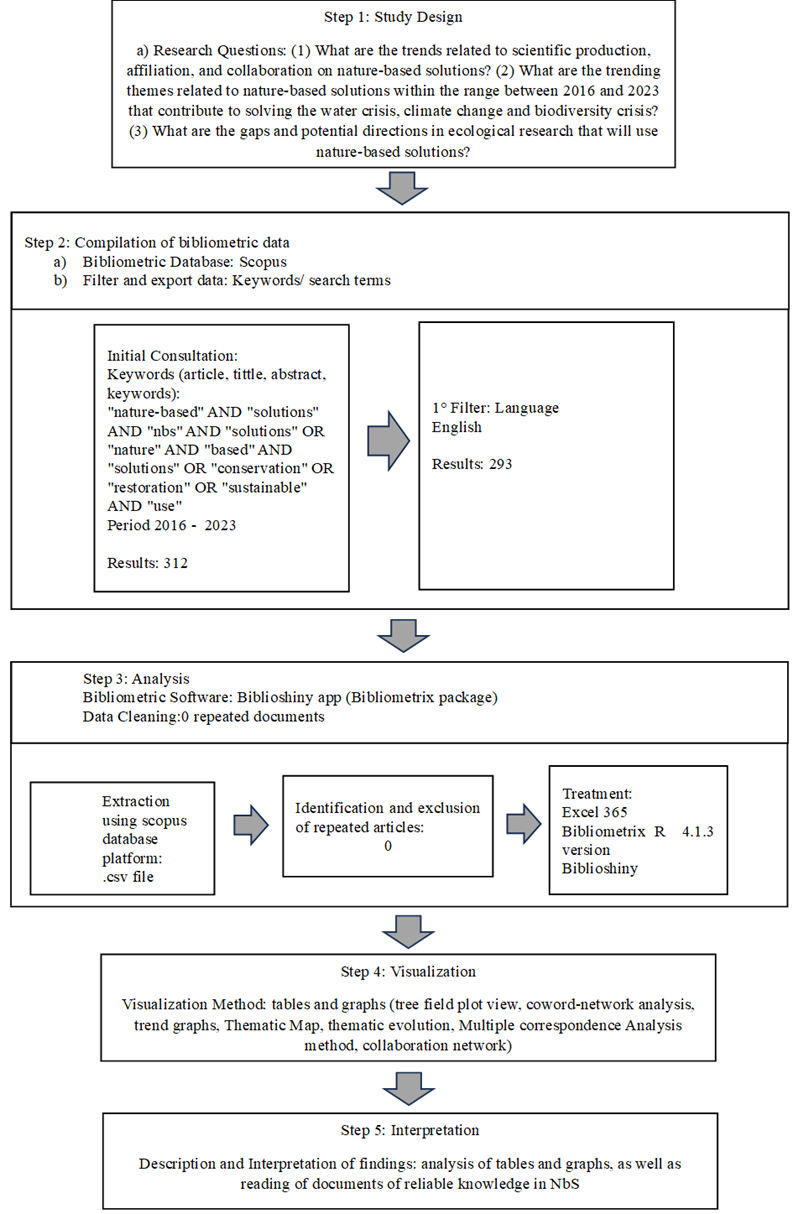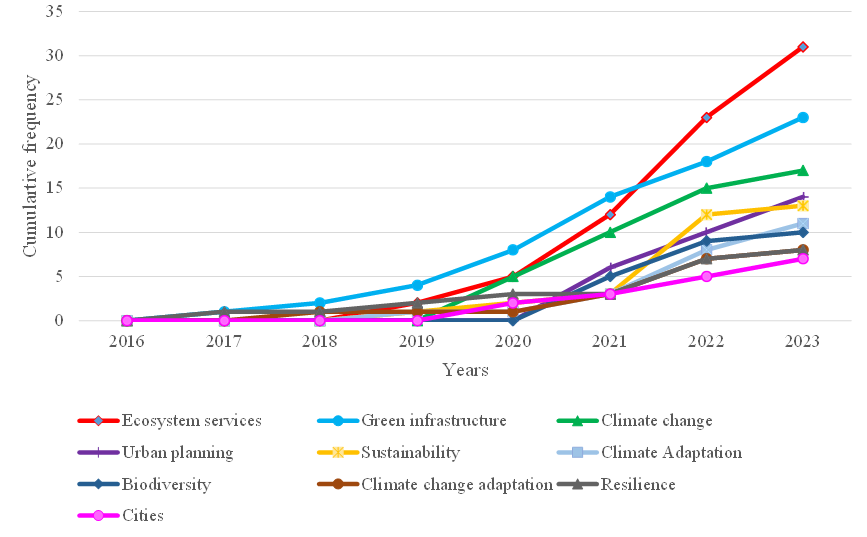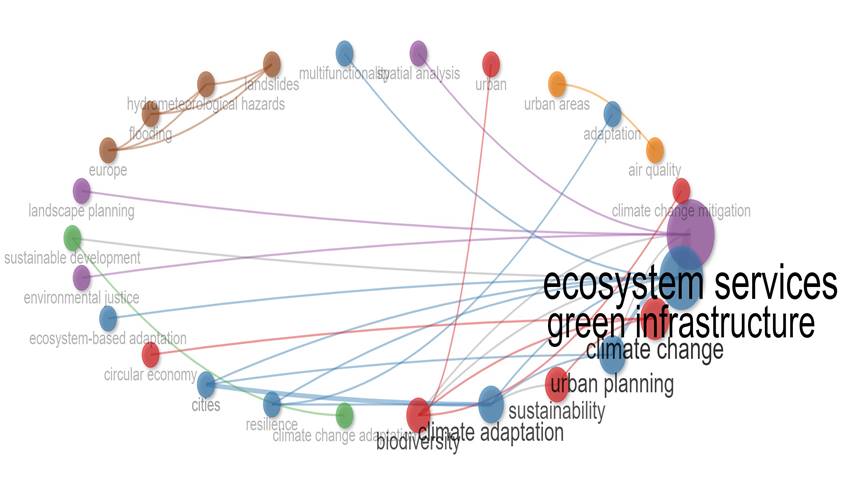Introduction
The most accepted international definition of Nature-based Solutions (NbS) was proposed by The International Union for Conservation of Nature (IUCN, 2016), which defined NbS as interventions with the aim of protection, sustainable management and natural restoration or ecosystem modification to cope with societal challenges effectively and adaptively, as well as providing human well-being and biodiversity benefits. Although the first appearance of this term was at the beginning of the 2000s, as it was pointed out by Liu et al. (2021), it was until 2016 that the IUCN released the official definition, which sets the timeframe for this bibliometric analysis. The term Nature-based Solutions emerged mainly from the disciplines of land use management and planning and also from water resource management. These previous fields of knowledge developed strategies such as using natural systems like natural wetlands, but using engineering systems that adapt the former to generate constructed wetlands not only for wastewater tertiary treatment but also for secondary treatment, at different scales, charge capacities and types of wastewaters (Langergraber et al., 2020). The European Commission also used this term under its Seventh Framework Program (FP7) and H2020 Framework Program and has kept promoting NbS with its Green Deal Calls as well as Horizon Europe calls (European Commission, 2015, 2017). The European Commission in its revised definition considers NbS as inspired and supported by nature, cost-effective, and simultaneously providing environmental, social, and economic benefits that help build resilience. Such solutions bring more, and more diverse, nature and natural features and processes into cities, landscapes, and seascapes, through locally adapted, resource-efficient and systemic interventions (Liu et al., 2021). The European Commission focuses its approach on living solutions, while IUCN considers NbS as actions and focuses its approach on constantly applying sustainable management and conservation of natural resources, to overcome societal challenges like climate change, water security, food security, and natural disasters (IUCN, 2016; Nesshöver et al., 2017).
These definitions which cover different topics at different contexts and scales, make it possible to consider NbS as an “umbrella” term. Within and across the NbS definition, other themes can be found such: as Green Infrastructure (GI), Blue Infrastructure (BI), Blue Green Infrastructure/Green Blue Infrastructure (BGI/GBI), Ecological Engineering (EI), and Ecosystem-based Adaptation/Mitigation (EbA/EbM), between others. All these terminologies aim for sustainability based on ecosystems, mainly because of the understanding that socio-ecological systems, where humans live and depend on, have an undeniable relationship with ecosystems, hence these terms must be understood within the characteristics of socio-ecological systems and manage them embracing their features (Kay et al., 1999; Folke et al. 2011).
In the global context, due to the different causes and circumstances of societal challenges, governments from different parts of the world used their policy frameworks to implement, maintain and extend research in NbS. One of the most important frameworks is from the European Union Research and Innovation Program on seven types of important international projects for NbS research (European Commission, 2019). In the case of China’s framework, the government promoted the ecological conservation redline system (Gao et al., 2020), local government heads for rivers and lakes (Shen, 2021), international coalition for green development on the belt and road (Coenen et al., 2021), natural forest protection, afforestation, and sustainable forest management (Wang et al., 2021), urban ecological restoration (Hai et al., 2003). This, later on produced the initiative of Sponge cities, which frame design considers linking the NbS approach with other developed countries approaches to achieve urban resilience trough flooding control, improvement of water environment, water resource conservation and water ecology rehabilitation (Biswas & Hartley, 2017; Baihao et al., 2018; Yin et al., 2022). Because of different international initiatives of the different types of NbS concepts and frameworks, it is necessary to categorize the types of NbS implementations. For instance, Eggermont et al. (2015), as well as Harrak M. & Lemaitre (2023), categorize NbS considering the degree of these interventions as i) Solutions that involve making better use of existing natural or protected ecosystems (e.g., measures to increase fish stocks in an intact wetland to enhance food security); (ii) Solutions based on developing sustainable management protocols and procedures for managed or restored ecosystems (e.g., re-establishing traditional agro-forestry systems based on commercial tree species to support poverty alleviation) and (iii) Solutions that involve creating new ecosystems (e.g., establishing green buildings, such as green walls and green roofs). Another important categorization regarding the degree of intervention/level and type of engineering in many (sub)categories (Somarakis et al., 2019) comprises: i) Better use of protected/natural ecosystems, e.g., protection and conservation strategies in terrestrial (e.g., Natura 2000-a network of nature protection areas in the territory of the European Union), marine (e.g., marine protected area), and coastal areas (e.g., mangroves) ecosystems; ii) NbS for sustainability and multifunctionality of managed ecosystems, such as agricultural landscape management, coastal landscape management, extensive urban green space management, and monitoring; and iii) Design and management of new ecosystems, for example, intensive urban green space management, urban planning strategies, urban water management, ecological restoration of degraded terrestrial ecosystems, restoration and creation of semi-natural water bodies and hydrographic networks, and ecological restoration of degraded coastal and marine ecosystems.
Likewise, with the advances of the Seventh Framework Program (FP7) and H2020 Framework Program, considered one of most successful initiatives between European countries for NbS research, the categorization of NbS needed a practical and clear way to categorize NbS types. One of the examples of such categorization was the NbS research realized for the PHUSICOS project by the Bureau de Recherches Géologiques et Minières (2020) under the coordination of the Norwegian Geotechnical Institute, conducted from 2018 to 2022. Anderson & Gough (2022) proposed a more detailed manner to promote implementation and scaling through a typology for the systematization and application of NbS as well as for its alignment to the United Nations Sustainable Development Goals (UN SDG). This was considered also by Akoumianaki & Pakeman (2023) that investigated the role of biodiversity in the design, delivery, and benefits of NbS; with the aim of having more impact for policy and society considering the European Biodiversity Strategy for 2030 (European Commission, 2021).
From these categorizations, the development of NbS research has evolved in different contexts due to factors such as scale, i.e. global, regional and local realities between countries; technology available; economic and financial resources; environmental conditions, social, legislative and institutional conditions. One of the threats of the current societal development, climate change, has made the adaptation of emergent and developing countries (the most vulnerable countries) harder. Consequently, these countries implement to a lesser extent or do not implement NbS projects due to their circumstances, such as scarce budgets to solve environmental problems, social instability, among others.
As research on NbS emerge in importance, a bibliometric analysis is useful and timely. Bibliometric analysis is a method that quantifies development of research in different fields and identify relevant trends; it studies the development process of academic research areas, recognize current pertinent themes, and predict future research directions (Aria & Cuccurullo, 2017). Along with visual mapping generated by bibliometric software, bibliometric analysis provides a systematic and detailed description of the knowledge context of the research area (Martínez et al., 2015; Zhang et al., 2022). The research reported in this article could help researchers interested in working within the NbS research area to identify relevant topics, information needs or themes with most advances in the NbS area related to climate change, water, and biodiversity crisis at different scales and government levels. Hence, our bibliometric analysis aims at answering the following research questions:
(1)What are the trends related to scientific production, affiliation, and collaboration on NbS?
(2)What are the trending NbS themes studied within the range between 2016 and 2023 that contribute to solving global problems like water crisis, climate change and biodiversity crisis?
(3) What are the gaps and potential directions in ecological research that could use NbS?
Materials and methods
Data collection
In July 2023 we searched the Scopus database, because of its international standards to categorize and organize traits of the scientific literature worldwide, and because it allowed us to export the search results in different formats, such as .csv. We conducted our search using keywords related to NbS (period 2016-2023) as it shown on Table 1, with the search string limited to the title, abstract, and keywords so that the reference of the research articles had a direct and explicit mention of the topics related to NbS. In order to not ignore the interaction of NbS research area with other fields of science we did not restrict the fields of knowledge, only using the most common words related to NbS within the fields of environmental management and sustainability, selecting for this review: restoration, conservation, sustainable and use. We were also restricted to the English language. We used data filters for the verification of the documents from the database in order to avoid duplicates and information that is not related with the central theme of our review. A summary of the steps taken to obtain our database can be seen in Figure 1.
Data analysis
We used an adaptation of the method developed by Ullah et al. (2023) because it is practical and uses open-source software such as R packages, that are easily available and reproducible. In this bibliometric analysis we used the Bibliometrix R package, which was developed by Aria & Cuccurullo (2017) and can generate analytics for the thematic trends, such as trend topics, three plot-field diagrams, co-authorship network, thematic Maps, thematic evolution, factorial analysis as well as maps of global collaboration and contribution in the topics related. Bibliometrix also allowed us to obtain descriptive statistics of the articles found. We complemented this analysis by carefully reviewing each article, so to contextualize the results obtained with Bibliometrix.
Descriptive Analysis
We used descriptive statistics such as the annual increase rate percentage in articles, average citations per document, average document age, international co-authorships percentage, co-authors per document, single-authored documents, frequency of author’s keywords and document types. These were used to identify the main evidence regarding the scientific production, the main sources, the most important countries of correspondence, words more frequently used, as well as data about the authors with the highest impact globally.
Table 1 Database search along with the search strings, retrieved documents, and data format.
| Database | Search Terms | Number of documents | Data Format |
|---|---|---|---|
| Scopus | (TITLE-ABS-KEY("nature-based" AND "solutions" AND "nbs" AND "solutions" OR "nature" AND "based" AND "solutions" OR "conservation" OR "restoration" OR "sustainable" AND "use") AND PUBYEAR > 2015 AND PUBYEAR < 2024 AND ( LIMIT-TO ( LANGUAGE,"English" ) ) ) | 293 | .csv |
The indexes used to characterize scientific production were the following: (1) h-index: which measures the author’s production as well as the impact of their publications, is related to the most cited papers by the author as well as citations the author received in other publications (Wang et al., 2022); (2) g-index, that measures the global citation performance of a set of articles, it means that a set of papers has a g-index if g is the highest rank such that the top g papers have, together, at least g2 citations (Wang et al., 2022); and (3) m-index, which is the h-index divided by the number of years since the author released their first publication, allowing for the incorporation of the career span of the author (Wang et al., 2022).
To analyze visually the relationship between the affiliation country of the most influential correspondence author and the keywords that used in the documents analyzed, we used the three-plot diagram. In the plot, the colors of each bar represent the frequency related in the respective case if corresponds to country affiliation, author and keywords used within the database analyzed.
Mapping of conceptual structure
To represent graphically the scientific themes, we used the following two science mapping methods.
Co-occurrence Network
We evaluated the co-citation network (Cobo et al., 2011) to uncover the collaboration between institutions using the co-citation collaboration network. The network consists of nodes which are circles that represent a word that is co-cited with other words in a set of documents; the other graph component is the edge, which represents the link between word occurrences, the size of the edge increases if the number of co-occurrences increases as well.
Collaboration between institutions
We used the collaboration map from the Bibliometrix package to analyze the collaboration between countries as well as the scientific production of each country analyzed in the database.
Collaboration between countries
We used this option to obtain a collaboration world map, where the countries with more activity are darker colored than the other countries in doing research according to the database analyzed. The map also provides lines that indicate participation with other partner countries.
Thematic Map
We used the Biblioshiny app from Bibliometrix R Package to obtain the thematic map which represents the themes in a given domain (Cobo et al., 2011), that consisted of 4 quadrants that represent the following:
( The upper right quadrant corresponds to motor themes, related externally to concepts applicable to other themes that are conceptually closely related. They are well developed and highly relevant in the research area.
( The upper-left quadrant corresponds to niche themes that are isolated, very specialized, and peripheral.
( The lower-left quadrant is both weakly developed and emerging or disappearing themes.
( The lower-right quadrant represents basic themes, usually transversal to other themes.
Multiple Correspondence Analysis (Factorial Analysis Approach)
This method consists of reducing the different dimensions that have the documents of the database so they can be analyzed between the different themes organized in clusters in just two dimensions. The thematic area is defined by a polygon representing a group of words or concepts from a set of publications more homogeneous and proximate to each other, configuring a conceptual structure (Cobo et al., 2011). If necessary, the software can differentiate another polygon and assign it another color by default. Is important to mention that the proximity of the polygon to the center of the two-dimensional axis makes it more frequent in word occurrence, shared between documents and important in the database analyzed.
Thematic Evolution
We used the Biblioshiny app from the Bibliometrix R Package to obtain the thematic evolution in the NbS research area. The graphic obtained according to Cobo et al. (2011) corresponds to a Sankey Diagram divided by bars that contains different colors that differentiate the clusters produced. The size of the bars within each period means the frequency of the themes associated with the number of documents related. If a bar of one color has the same name with no entries means that the theme did not vary, but then if the main theme in the next period is increased with other previous themes means that the theme has evolved with other entries in the research area. If the bar did not have entries or disappeared later means that that theme did not continue to be a trending topic within the NbS research area. The edges in gray indicate belonging from a thematic area in one period to the next period.
Results and Discussion
Descriptive statistics of the documents analyzed
We included in the review 293 documents, mainly research articles and reviews (Table 1). The average number of citations per document was 11.43, while the number of co-authors per document was 5.24, meaning that usually 4 or 5 authors collaborate on the documents and 43.69% are from different countries (Table 2).
Table 2 Descriptive statistics of the literature analyzed.
| Description | Results |
|---|---|
| Timespan | 2016:2023 |
| Sources (Journals, Books, etc) | 125 |
| Documents | 293 |
| Annual Growth Rate % | 77.72 |
| Document Average Age | 1.65 |
| Average citations per doc | 11.43 |
| References | 19 797 |
| DOCUMENT CONTENTS | |
| Keywords Plus (ID) | 1 612 |
| Author's Keywords (DE) | 1 056 |
| AUTHORS | |
| Authors | 1 336 |
| Authors of single-authored docs | 20 |
| AUTHORS COLLABORATION | |
| Single-authored docs | 20 |
| Co-Authors per Doc | 5.24 |
| International co-authorships % | 43.69 |
| DOCUMENT TYPES | |
| article | 213 |
| book | 1 |
| book chapter | 26 |
| conference paper | 17 |
| conference review | 1 |
| editorial | 2 |
| note | 3 |
| review | 30 |
Table 3 shows the average production at a global scale from the most relevant sources of documents (i.e. journals). The journal “Sustainability (Switzerland)” is the most productive source (42 articles), followed by “Environmental Science and Policy” (17 articles), and in third position “Science of the Total Environment” (13 articles). These three journals cover a broad range of topics, but “Sustainability (Switzerland)” covers a wider range of topics, considering both open science and open access that can support the 2030 Agenda for Sustainable Development adopted by United Nations. Likewise, Figure 2 shows the scientific production of the documents analyzed as well as the collaboration between countries: the country in first position is Italy, then the United Kingdom in second position, and third position, the United States of America. The continent that has more collaboration within the continent and beyond is Europe. Between countries from Latin America and the Caribbean, Brazil has 7 collaborations, Ecuador 7 collaborations, Colombia 5 collaborations, Costa Rica 3 collaborations, Dominican Republic 3 collaborations, Peru 2 collaborations and Guatemala 1 collaboration.
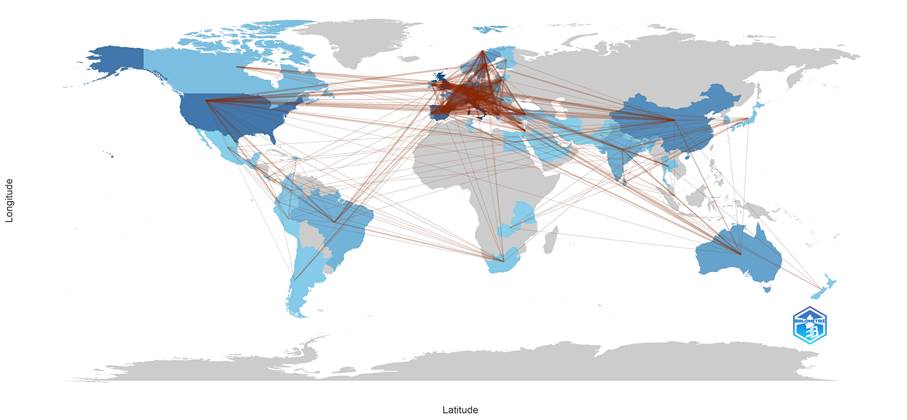
The figure shows the countries with more activity (the bluer the greater the activity) in doing research according to the database analyzed. The brown lines indicate participation with other partner countries.
Figure 2 Collaboration Map on worldwide NbS research.
Table 3 Most relevant sources in the NbS literature.
| Element | h_index | g_index | m_index | TC | NP | PY_start |
|---|---|---|---|---|---|---|
| SUSTAINABILITY (SWITZERLAND) | 11 | 15 | 1.571 | 296 | 42 | 2017 |
| URBAN FORESTRY AND URBAN GREENING | 9 | 12 | 1.8 | 359 | 12 | 2019 |
| ENVIRONMENTAL SCIENCE AND POLICY | 6 | 10 | 2 | 113 | 17 | 2021 |
| JOURNAL OF ENVIRONMENTAL MANAGEMENT | 6 | 10 | 1.2 | 114 | 12 | 2019 |
| SCIENCE OF THE TOTAL ENVIRONMENT | 6 | 13 | 1.2 | 264 | 13 | 2019 |
| ENVIRONMENTAL RESEARCH | 5 | 5 | 0.714 | 240 | 5 | 2017 |
| WATER (SWITZERLAND) | 5 | 10 | 0.833 | 132 | 10 | 2018 |
| BLUE-GREEN SYSTEMS | 4 | 4 | 1 | 74 | 4 | 2020 |
| FRONTIERS IN ENVIRONMENTAL SCIENCE | 4 | 6 | 0.667 | 75 | 6 | 2018 |
| AMBIO | 3 | 5 | 1 | 30 | 5 | 2021 |
TC: Total Citations. NP: Number of publications PY_start: Publication Starting Year.
The Most Relevant Sources in NbS Literature
According to Table 3, considering the h-index that indicates the number of publications and citations of a researcher, g-index that scores the most frequently cited papers over time and m-index that showcases the careers span of a researcher since their first publication, we found that “Sustainability (Switzerland)” conserves its position, then in second position “Urban Forestry and Urban Greening”, and in third position “Environmental Science and Policy”, and in fourth position the “Journal of Environmental Management”. It is important to mention that the last journal source has fewer publications but a significant impact on NbS research considering the h-index, g-index and total citations. Besides the indexes, the publication starting year most frequent was 2019.
The Most Relevant Corresponding Authors
As shown in Table 4, considering the h-index, g-index and m-index, the author with more impact was Albert C, whose research focus on spatial analysis to identify potential areas that could function as NbS considering a landscape planning approach and governance. This author comes from Leibniz University Hannover, an affiliation with the higher h-index, g-index and m-index, total citations as well as number of publications. The next author was Guerrero P, whose research ins focused on NbS considering the landscape approach and governance also from Leibniz University Hannover. In third position Haase D, focused their research on NbS considering the landscape approach and governance, affiliated to the Humboldt University of Berlin. It is important to notice that these most influential authors began to publish their articles in 2018, not in 2016 as happened with Lafortezza R that studied vegetation cover as NbS as well as other terms like green infrastructure and urban forests in urban landscapes from the University of Bari Aldo Moro, who has the highest number of citations. Another important fact was that Baganz GFM from RWTH Aachen University, begun publishing later in 2021 but has the same h-index and g-index than authors that published earlier like Dorst H (Utrecht University) and Lafortezza R, although this last researcher mentioned has much more total citations. Baganz GFM research deals with the possible integrations between NbS and Circular Economy in cities, while Dorst H studied the traits of NbS and implications in urban planning practices considering green infrastructure and ecosystem-based adaptation.
The Most Relevant Countries by Corresponding Authors
As can be seen in Figure 3 the country with more article participation is the United Kingdom, in second position Italy, in third position China, in fourth position USA. The countries that have the lowest Multiple Country Publications ratio in this list of first ten countries ranking are Poland and Germany. This result has similarities with Figure 2, that in terms of scientific production shows that Italy (160 documents) is the country with more documents analyzed in the database, followed by the United Kingdom (136 documents) and in third position the USA (114 documents). An explanation for these trends could be related to the policies, funding for research and level of governance organization at different scales that promoted NbS in those countries. An example of this is the case of countries in Europe, that established the Green Deal Calls as well the Europe Horizon Calls in frameworks like the Seventh Framework Program and H2020 Framework Program to fund projects for improvement of the knowledge in NbS (Calliari et al., 2022).
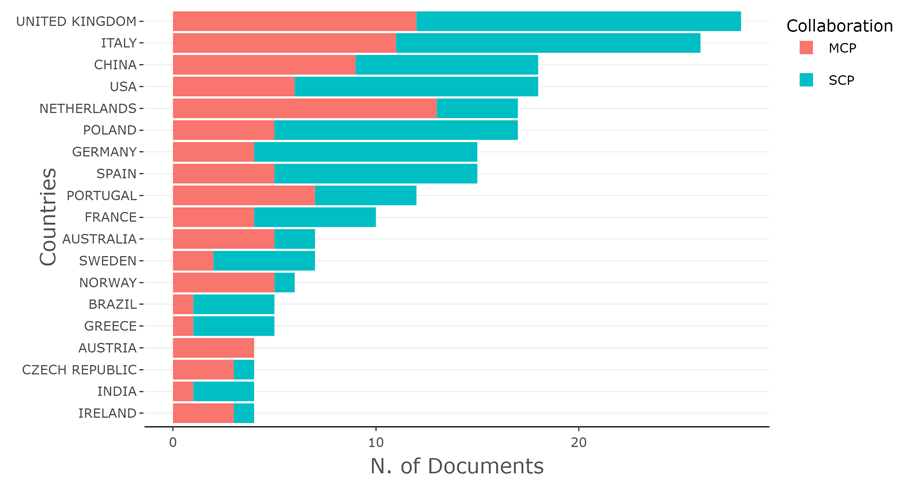
Figure 3 Corresponding author’s countries considering single country participation or multiple countries participation.
Table 4 Most influential authors in the NbS literature.
| Element | ORCID | Country Affiliation | h_index | g_index | m_index | TC | NP | PY_start |
|---|---|---|---|---|---|---|---|---|
| ALBERT C. | 0000-0002-2591-4779 | Germany | 5 | 7 | 0.833 | 192 | 7 | 2018 |
| GUERRERO P. | 0000-0002-6501-0184 | Germany | 4 | 4 | 0.667 | 168 | 4 | 2018 |
| HAASE D. | 0000-0003-4065-5194 | Germany | 4 | 5 | 0.667 | 169 | 5 | 2018 |
| BAGANZ G.F.M. | 0000-0002-6511-8638 | Germany | 3 | 3 | 1 | 46 | 3 | 2021 |
| CAPOBIANCO V. | 0000-0001-8959-3436 | Norway | 3 | 3 | 1 | 28 | 3 | 2021 |
| DORST H. | 0000-0003-2570-9553 | Netherlands | 3 | 3 | 0.6 | 175 | 3 | 2019 |
| KALSNES B. | 0000-0003-2981-5732 | Norway | 3 | 3 | 1 | 28 | 3 | 2021 |
| LAFORTEZZA R. | 0000-0003-4642-8435 | Italy | 3 | 3 | 0.375 | 307 | 3 | 2016 |
| LOUPIS M. | 0000-0002-2349-9946 | Greece | 3 | 4 | 0.6 | 131 | 4 | 2019 |
| RAVEN R. | 0000-0002-6330-0831 | Netherlands | 3 | 3 | 0.6 | 175 | 3 | 2019 |
Note. TC: Total Citations. NP: Number of publications. PY_start: Publication Starting Year.
The most frequent thematic and relationship with authors and countries
As shown in Figure 4, the blue lines indicate the timeline of the occurrence of the topic analyzed in NbS research. The most frequent topic is “ecosystem services” with a frequency of 31 in the 2021 to 2022 timeframe, then “green infrastructure” with a frequency of 23 from 2020 to 2022, then “climate change” with a frequency of 17 in the same timeframe. The next trend topic is “urban planning” in the timeframe 2021-2023 with a frequency of 14, and a frequency of 13 for “sustainability” only during 2022. Another trend topic was “governance”, from 2020 to 2022 with a frequency of 7; while at a similar timeframe, 2020-2022, “ecosystem-based adaptation” had a frequency of 6, and a frequency of 5 for “ecohydrology” during a timeframe from 2019 to 2022.
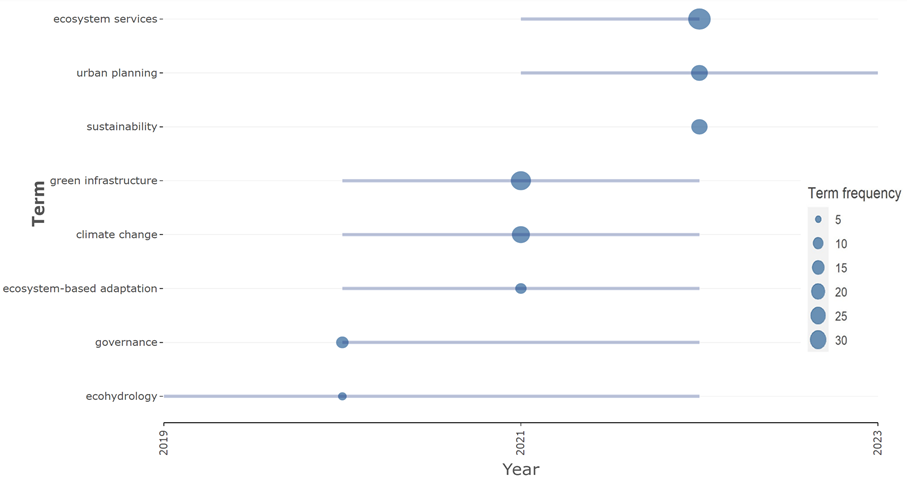
The blue lines mean the timeframe period from start to finish when a topic was a trend. The blue circle indicates the frequency of the term during the respective trend timeline.
Figure 4 Trend topics in the database analyzed for Nature Based Solutions.
In our review, the most common words associated to NbS during 2016 to 2023 in cumulative counts were “ecosystem services”, followed by “green infrastructure”, then “climate change”, then “urban planning”, “sustainability”, “climate adaptation”, “biodiversity”, “resilience”, “climate change adaptation” and finally “cities” (Figure 5). Ecosystem services were the most common associated keyword to NbS during the entire period and increased in frequency during the later years analyzed. These results indicate that NbS was more related to interventions in urban areas as were studied in different contexts like financial barriers, implementation frameworks, life cycle assessments, environmental impacts, among other themes related. For instance, Kalantari et al. (2022) used a method to identify the most optimal localization of an NbS type (constructed wetlands) for optimal performance to reduce flood risk and promote landscape connectivity of urban catchments. Ascenso et al. (2021) assessed of NbS (green roofs and green parks) in different cities with respect to air quality and temperature, finding that NbS can be a very good measure for reducing urban heat effect in cities. Overall, this research emphasizes that mainly because of the ecosystem services that provide NbS, it is necessary to address its constraints, multiple benefits and heterogeneity in a transdisciplinary way, in order to develop NbS projects in their respective time and space scales as well as involving them in the planning and governance frameworks for specific local context of implementation (Toxopeus & Polzin, 2021: Wickenberg et al., 2021; Larrey-Lassalle et al., 2022).
In concordance with Figure 3 and Figure 4, Figure 6 shows the relationship between the different countries of the first author of correspondence and the keywords of their research documents. This analysis shows that Germany, Portugal, the United States, Netherlands, Italy and United Kingdom are the most common countries from which the authors come from. On the other hand, the most frequent author’s keywords were nature-based solutions, ecosystem services, green infrastructure, climate change, sustainability, governance, environmental justice, biodiversity, circular economy, sustainable development, urban planning, and cities.
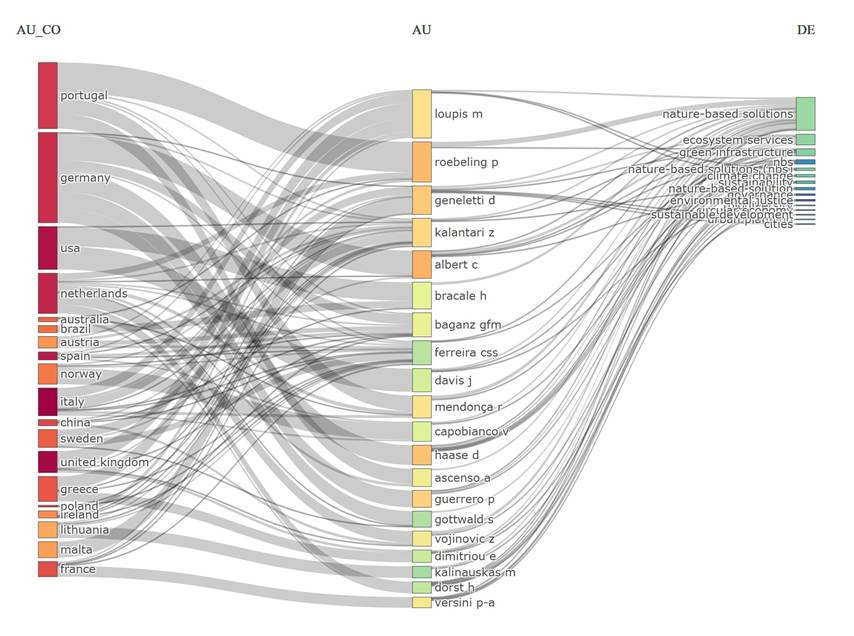
AU_CO: Affiliation Country of first Author. AU:Author. DE: Author Keywords. The size of the bars from the left indicates the occurrences of the nationality affiliation of the first author, the central bar indicates the most influential author analyzed and the bar on the right indicates the keywords used by these authors.
Figure 6 Three plot-field diagrams of countries, authors and keywords related.
Co-word network analysis for the NbS research
As shown in Figure 7, the “purple cluster” is the main cluster for the NbS research topic, and it is usually associated with ecosystem services, landscape planning and environmental justice. Another cluster is the “blue cluster”, which shows that green infrastructure is usually related to multifunctionality, urban planning, climate adaptation, resilience, cities, ecosystem-based adaptation, and adaptation. The third cluster is the “red cluster”, which shows that climate change is commonly related to sustainability, biodiversity, circular economy, climate change mitigation and urban-related themes. The fourth cluster (in brown), comprises landslides, hydrometeorological hazards, flooding, and Europe. The next cluster (in green) comprises climate change adaptation and sustainable development. Finally, the last cluster (in yellow) comprises urban areas and air quality. Amongst the clusters, the most important ones are the purple with ecosystem services, blue with green infrastructure and the red cluster with climate change, because they are the most common in the literature, and usually correspond to themes that are more present in the 2016-2023 period analyzed in the database. Such research was conducted by Cui et al. (2021) comparing approaches of NbS for urban water management in Singapore and Lisbon and finding that those cities have a common need of water supply (either domestic water supply or wastewater reuse for compatible uses), of flood control (and related climate change aspects, including coastal erosion prevention), and the construction of green and recreational areas. Cui et al. (2021) found that those needs can be solved with NbS as part of the solution against urban expansion, water use increase and climate change impacts. Krivtsov et al. (2021) developed a comparative theoretical ecosystem analysis (CTA) methodology framework to evaluate NbS, finding benefits of combining sustainable urban drainage systems (SUDS) and retrofitting green roofs such as improvement of local biodiversity, water quality improvement and alleviation of flood risk as well as its trade-offs related.
Thematic Map
The thematic map developed for the period 2016-2023 is shown in Figure 8. We found that motor themes (upper right quadrant) cover topics related to the applications of NbS mainly in urban areas such as urban greening, flood risk management, green infrastructure for environmental governance and restoration, green roofs as well as climate change and sustainability. These themes area highlighted by several authors related in the database analyzed like Croeser et al. (2021), who analyzed the necessity of choosing the most feasible NbS options for urban areas considering different criteria and pointing out again the multiple benefits of NbS and its specific local context related to which is more feasible in urban contexts. The basic themes (lower right quadrant) cover topics related mainly to ecosystems services, biodiversity and climate change specifically related to climate change adaptation, environmental justice, urban planning, ecosystem-based adaptation, land use change and river management. These themes are transversal to the rest of the other themes in the NbS research area and were covered by authors like Larrey-Lassalle et al. (2022), that included the aforementioned global themes to use a Life Cycle Assessment method for sustainability analysis and select urban NbS options in a broad sense. They also showed the particularities of NbS options in a specific context mainly because of the influence of local priorities and stakeholders, as well as the heterogeneity and multiple benefits that are usually constraints for implementation. The emerging themes (lower left) cover topics not so developed and peripheral on NbS such as perceptions of stakeholders about ecosystem services that promotes NbS and benefits instead of practice as usual or grey infrastructure (Hekrle, 2022; Moreau, 2022), contributions of NbS to net zero (Bradfer-Lawrence et al., 2021), and ecosystem-based solutions (Sowinska-Swierkosz, 2021) which is a term used to study allotment gardens in Poland. These themes are not so developed for NbS in extent compared with themes like Climate Change adaptation and ecosystem-based adaptation, that usually are transversal to NbS research. Finally, the niche themes (upper left quadrant) cover topics strongly developed although marginal for NbS, such as hydro-meteorological hazards, indicators, stakeholder engagement, land use land change (LULC), soil erosion, sponge city, natural flood management, landscape planning and hydrologic modelling systems (HEC-HMS). In this quadrant, for instance, Kumar et al. (2020) analyzed the literature about long-term measure for hydro meteorological hazards mitigation and reduction; Kuriqi & Hysa (2021) reviewed the novel approaches on NbS to promote natural flood management; Hale et al. (2023) evaluated the international evidence-based framework with indicators for NbS; and Ramírez-Agudelo et al. (2020) analyzed the lessons learned, monitoring indicators and stakeholder engagement in NbS for water management in peri-urban areas.Thematic Evolution
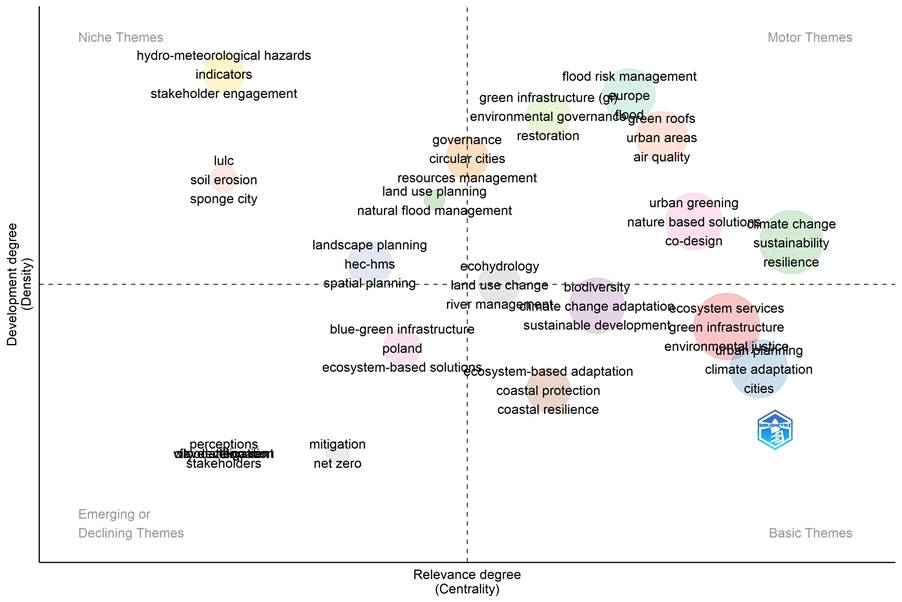
The upper right quadrant corresponds to motor themes, well developed and relevant for structuring the conceptual framework on NbS. The lower-right quadrant are basic themes, usually transversal to its different themes on NbS. The lower-left quadrant is weakly developed, peripheral, emerging or disappearing themes. The Upper-left quadrant corresponds to niche themes are strongly developed but still marginal for the NbS research area.
Figure 8 Thematic Map of keywords in the NbS literature.
Figure 9 explains the trends of themes in the different subperiods 2016-2018, 2019-2020, 2021-2022 and 2023-2023. In our review we found the first subperiod of research (2016-2018) was oriented mainly to green infrastructure, then in the second subperiod (2019-2020) other topics were covered such as environmental governance, climate change with circular economy in cities. In this regard, Frantzeskaki et al., (2020) studied the NbS implementation framework to analyze the gap between a strategy based in NbS to a solution, a policy problem and policy objective for cities, ecosystem-based adaptation, blue green infrastructure and flood risk management. In the third subperiod (2021-2022), there was a specialization with themes such as climate mitigation, climate adaptation, urban greening and codesign of NbS, ecosystem-based adaptation, green infrastructure as well as sustainability and resilience. In this subperiod, Castaldo et al. (2021) studied how to incorporate the ecosystem-based adaptation approach as part of NbS, through tools and indicators into urban planning. Likewise, some themes emerged as transversal such as biodiversity, environmental justice, ecosystem services, urban planning, and sustainability. Finally, in the fourth subperiod, the themes with potential for further research are water security, drought, Hydrologic Modelling System (HEC-HMS), landscape planning, sustainable development goals and climate change. These themes have been studied by authors such as Acosta et al. (2023) with the use of a Hydrologic Modeling System from the Hydrologic Engineering Center (HEC-HMS) and the Soil and Water Assessment Tool (SWAT) to estimate the NbS effects on watershed hydrology of different landscape scenarios; and Ciasca et al. (2023) with cost-benefit analysis (CBA) to assess the economic viability of NbS investments in a water supply system of Sao Paulo-Brazil in order to manage water security and to reduce the economic cost of drought. The transversal themes are flood management, green infrastructure, ecosystem services, environmental justice, and urban ecology. These themes can be found in research developed by Mabrouk et al. (2023) with simulations to assess of NbS effectiveness on flood management for cities in the MENA region; Liu et al.(2023) with the assessment on appropriate location of small dams as NbS option to control floods; and Raymond et al. (2023) with proposed approaches in order to enable senses of place, stakeholder engagement and just city transitions towards cities that integrate NbS in its urban spaces.
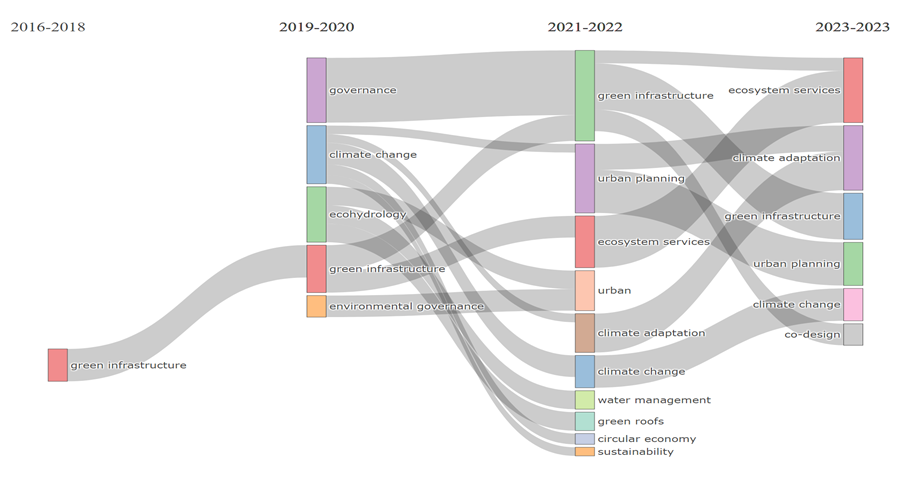
The colors of the bars are defined randomly and indicate the types of the more frequent thematic areas. The size of each bar indicates the number of occurrences of the respective thematic area. The size of the grey edges indicates the degree that corresponds to the thematic area from the previous thematic area of the previous subperiod.
Figure 9 Thematic Evolution of Nature Based Solutions Research.
Multiple Correspondence Analysis (MCA)
According to the Multiple Correspondence Analysis (MCA) performed (Figure 10) in our review, we found 4 clusters of research topics: cluster 1 (red), cluster 2 (blue), cluster 3 (green) and cluster 4 (purple). The predominant cluster of the diagram, closer to the center (red cluster), involves mainly themes more frequent in the database analyzed such as ecosystem services, climate change, sustainability, biodiversity, and water security. These findings are similar to the thematic Map and the thematic evolution of this bibliometric analysis, where recent research included within the database analyzed such as Larrey-Lassalle et al. (2022), as well as Ciasca et al. (2023) confirm the study of these themes. The second cluster closer to the center (blue cluster) comprises mainly themes such as climate adaptation, green infrastructure, landscape design, urban planning and sustainable development goals; these results are similar of those obtained with the thematic evolution and thematic map in themes like green infrastructure and urban planning that consider these themes as transversal, and have been studied in research within the database analyzed, like Mabrouk et al. (2023) as well as Longato et al. (2023) with the study of prioritization by combining mapping and assessment of demand of ecosystem services with the analysis of the potential supply of ecosystem services from different NbS types, so it can be decided which is suitable for specific and real life planning contexts. The third cluster, closer to the center (green cluster), comprises mainly themes such as co-design, co-benefits, decision support, participation, and well-being. These themes can been found in researches of the database analyzed, like Bogatinoska et al. (2022) about a proposed framework to use participatory tools for hydro-meteorological hazards (HMH), for the process of co-design NbS with the stakeholders and for co-implementing the transition to NbS. The fourth cluster (purple cluster) comprises mainly themes such as flooding, hydrometeorological hazards, landslides and Europe. These results especially for hydrometeorological hazards are in concordance with the thematic map developed considering this theme as an opportunity to develop further research. In this regard, research conducted by Kuriqi & Hysa (2021) as well as Spyrou et al. (2022) deal with the evaluation of efficiency NbS for flood reduction using in-situ information, satellite data and numerical simulations. Our analysis through the network and factorial approaches showed that only one article discusses the use of artificial intelligence in NbS research that was conducted by Sarabi et al. (2022). They developed an NbS Case-Based System, which used a hybrid architecture of artificial intelligence that can help in the planning and decision-making process concerning landscape planning, infrastructure development, the transformation of derelict areas, ecosystem protection, and restoration in urban and peri-urban areas.
Institutional collaborations
As can be seen in Figure 11, there are 6 clusters of collaborations. We found that the main clusters are the green cluster with collaborations between the University of Ljubljana, Wageningen University and Research as well as Stockholm University; the yellow cluster with collaborations between Glasgow Caledonian University, University of Glasgow, and University of Surrey; and the red cluster with collaborations between Germany and University of Natural Resources and Life Sciences Vienna (BOKU). These results are not in concordance with Figure 2 and Figure 5 with respect to the occurrences because the Netherlands and Sweden do not appear to be the first countries with international collaborations. A possible explanation is that Figure 10 measures how closer was the collaboration as well as how direct was the collaboration between the institution participants.
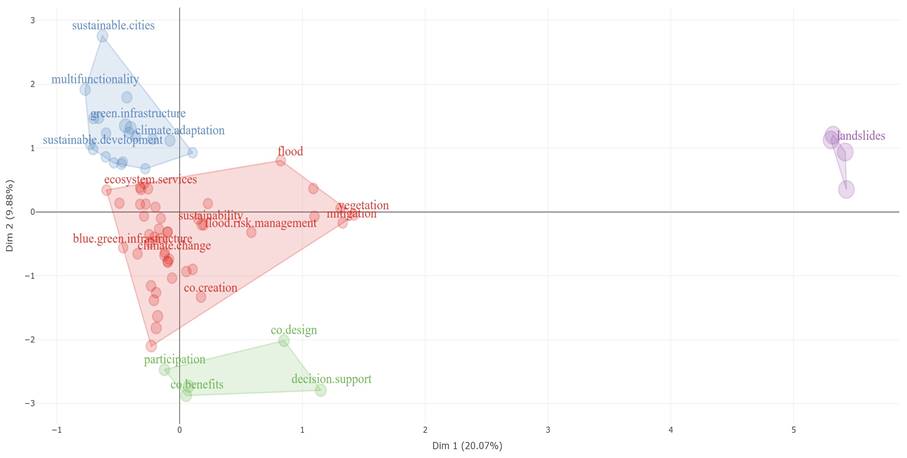
The graphic indicates homogeneity between themes. Each polygon of different color evidence homogeneity and proximity between themes (conceptual structure). The closer the polygon is to the central axis the more frequent are those themes in the database analyzed.
Figure 10 Conceptual Structure Map (Multiple correspondence Analysis method).
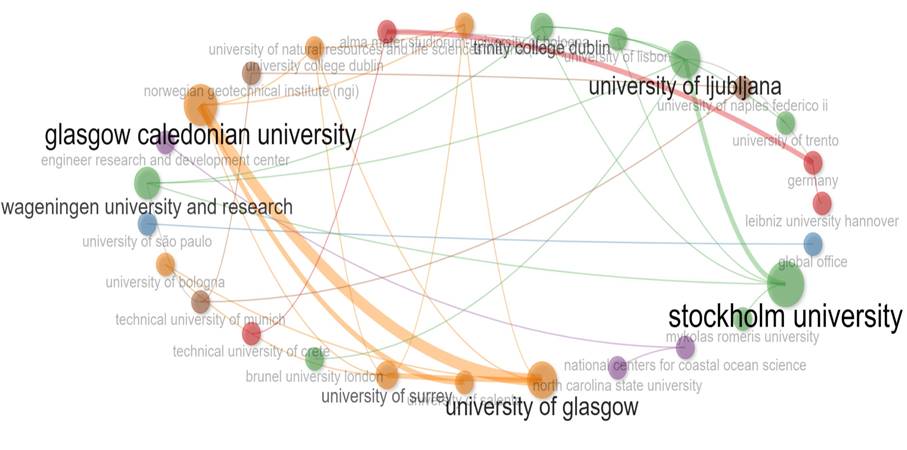
The graph shows the collaboration network between universities. The color indicates the cluster identified. The bigger the size of the circle the bigger the collaborations between them. The edge indicates the closeness between universities.
Figure 11 Institutional collaborations within the NbS literature.
Conclusions
This study uncovers the worldwide general trends in research on the subject of NbS from 2016 to 2023. The trends in scientific production evidence an increasing interest in this topic with a 77.72% annual growth rate and an average of 11.43 citations per document. In terms of affiliation and collaboration, the topic has been mainly developed by authors from the United Kingdom (28 articles), Italy (26 articles), China (18 articles) and the USA (18 articles). These authors published in journals such as Sustainability (Switzerland), Urban Forestry and Urban Greening, as well as Environmental Science and Policy, as main sources. Likewise, the significant international collaboration of multiple countries (43.69%) can improve the number and the quality of the research production on this research topic. Regarding the trending themes related with NbS over the period between 2016 and 2023, the more frequent words were ecosystem services, green infrastructure, and climate change; these words were later confirmed as transversal topics that are related to their research themes through the evolution in the period analyzed.
Over the study period regarding the motor themes, NbS research began with themes initially separated like green infrastructure as past trend, but then the complexity of societal challenges at the international level increased its importance internationally mainly because of climate change. Then NbS were investigated together with new themes related to ecosystem-based adaptation, cities and environmental governance and circular economy. Afterwards, those trending motor themes became more specialized and integrative than previous research in trying to incorporate holistic approaches to develop NbS considering environmental, economic and financial, social, legislative, institutional and technological aspects, in current themes such as water security, drought, sustainability of cities, sustainable development goals, but not leaving out transversal themes such as ecosystem services, climate change, biodiversity, green infrastructure and urban planning, which are basic and at least mentioned in all the NbS research. These themes contributed to solve global problems like the water crisis, climate change and the biodiversity crisis through frameworks, approaches, methods and tools for the different stages of development of NbS such as design, planning, implementation, maintenance as well as monitoring, and were almost present since 2016, beginning with explorative and descriptive studies then expanding the knowledge until the implementation at different scales in specific real local contexts regarding the different frameworks of governance in different countries, mainly in urban spaces.
In this review we found that the Global South development on NbS research is slower than the Global North. For example, in Latin America and the Caribbean (LAC) countries, scientific reliable research is still in development and is not as intensive as in the developed countries of the North Hemisphere, in spite of the crisis in loss of biodiversity, environmental disasters, and floods issues. In our review we found scarce published evidence from NbS in LAC countries, however the synthesis reported here represents a starting point to learn and use the experience and knowledge towards its implementation. Additionally, more collaborative initiatives at different levels of government for several countries, including LAC, should be promoted, especially considering global agendas such as the United Nations Sustainable Development Goals.
The gaps with potential for further research found in this bibliometric analysis are mainly the constraints due to the intrinsic traits that NbS need to solve, like its heterogeneity, the quantification of the multiple and variable benefits that NbS provides during their lifetime that are not usually manifested in short term, and the necessity to address NbS stages in a more transdisciplinary perspective. Considering these gaps, the potential direction of research trends on NbS is the use of industry 4.0 technologies and applications for those constraints, for example, the Generative Artificial Intelligence to improve planning, implementation and performance of Nature-based Solutions because only one study has done it so far. Another potential direction could be the contribution of NbS in niche themes like using Hydrologic Modeling System (HEC-HMS) to understand hydrometeorological hazards and its possible reduction and/or prevention as a consequence of NbS projects for sustainable watershed management and its implications in its different components, scales and contexts, that can be integrated at multiple levels of governance in different countries. There is a need for social themes like stakeholder engagement in NbS projects in participatory design, as well as indicators for the evaluation of NbS performance in its different dimensions in a more transdisciplinary way suitable for multiple levels of governance and not only in urban areas.
Finally, considering all the variability in the types of NbS in literature and its undeniable heterogeneity we propose an adaptation of the typology that was used for the PHUSICOS project by the Bureau de Recherches Géologiques et Minières (2020), that belongs to the Seventh Framework Programme of the European Commission, the analysis carried out by Anderson & Gough (2022) and the scope review developed by Akoumianaki & Pakeman (2023). This proposed typology is the following:
1. The nature of impacted ecosystems. This needs to be clearer and easier to identify. For example, mountains, rivers, wetland, urban, grassland, woodland, cropland.
2. The hazard concerned.
This can be but not restricted to floods, flash floods, rainfalls, landslides, rock falls, debris flows, snow avalanche, erosion, heat waves and droughts.
3. The other themes treated by the NBS.
This could be the following:
(i) Protection.
(ii) Sustainable management (other than protection or restoration).
(iii) Restoration.
(iv) +Habitat creation.
(v) Combination of protection and management actions.
(vi) Combination of protection and restoration actions.
(vii) Combination of management and restoration actions.
(viii) Combination of actions in created and natural/semi-natural ecosystems (created/non-created).
4. The type of exposed assets. The type of exposed assets can be but not restricted to urban, residential, roads, agriculture, and natural assets.
5. The UN Sustainable Development Goals that NbS aims to contribute. This typology makes explicit the main factors for consideration when classifying existing NbS initiatives, and for the design of further research and development projects related to this area. This proposal can be calibrated when applied to multiple contexts for one or several countries, their environmental constraints and at different scales of government.












 uBio
uBio 

